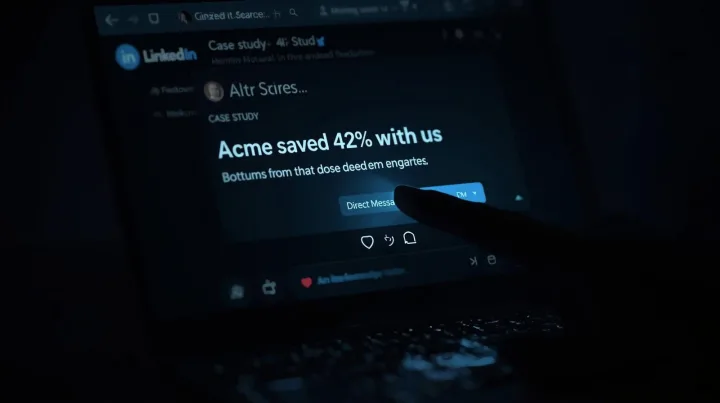The cold form is no longer used; instead, the DM to demo funnel is. One simple message on LinkedIn DMs that says, “Hey, does this work with Slack?” books more demos than gated ebooks. Why? Because DM to demo bypasses friction, creates trust in real time, and quickly translates curiosity into calendar invites. This strategy isn’t just talk. Companies that use a structured DM to show off their system get 3 to 5 times more replies than those that fill out a form. The DM to demo playbook below shows every step, from the scroll that starts the DM to the reply that qualifies to the handoff that books the demo. Let’s use your DM to demo the machine.
Why DMs Are the New Way to Find Things Call
From frigid forms to warm talks
Forms are dead when they get there. A survey by Unbounce in 2024 discovered that 79% of B2B leads leave forms after filling out three fields. Type DM to see a demo:
- No gatekeeping: no email, no company size, and no “tell me your biggest challenge.”
- Tone, pace, and personality replace dropdowns for instant rapport.
- Signal above noise means that a DM is serious. One form is hope.
It’s easy to switch from DM to demo: just move the qualification from before the chat to during the talk.
Where DMs fit into modern B2B sales funnels
| Stage | Old Funnel | DM to Demo Funnel |
|---|---|---|
| Awareness | Ad → Landing Page | Ad → Profile → DM |
| Interest | Fill out the form. | “Quick question…” |
| Thoughts | Email Nurture | 3 message threads |
| Intent | Book Demo | Link to Calendly in DM |
The DM to demo funnel shrinks from TOFU to MOFU in less than five minutes.
Mapping the Journey: From Scroll to DM to Demo

What really makes people DM?
Not every scroll turns into a DM. The ideal DM to show off triggers is
- Specific proof: “I saw your case study with Acme. Can this work for 500 seats?”
- Pain resonance: “We’re overwhelmed by Zapier hacks—please assist!”
- Social signal: “I just saw [influencer] mention you—I’m curious.”
The first step to a successful DM demo is to look at trigger density, which is how many scroll-stopping moments (such as case studies, testimonials, and big statements) are above the fold.
The first answer: tone, clarity, and expectations
The DM starts to demo velocity with your initial answer. Use the 3C Framework:
- Curiosity: “I love that you caught the Acme case. Can I ask what you’re trying to solve?”
- Clarity: “I would be happy to show you the details live in 15 minutes.” Does that work for you?”
- Control: “If now isn’t a suitable time, here’s my Calendly.”
A strong initial reaction moves DM from 0 to 60 in one message.
From going back and forth to “this is the next step”
There are only 2–4 communications between the DM and the demo handoff:
- Context: “We have 200 people on our team and use Slack a lot.”
- Qualify: “Got it—budget approved for Q1?”
- Close: “Great. Here’s 15 minutes tomorrow: [Calendly].”
The DM to demo rule states that a thread should never remain inactive for more than 24 hours.
Making DM Scripts That Don’t Sound Like Scripts
Micro-prompts that ask for context
Instead of saying “How can I help?” say “DM to demo micro-prompts.”
- “What’s the most important integration you need?”
- “Quick: Teams or Slack?”
- “What’s wrong with your current stack?”
These transform DM and demo replies into data with numerous signals.
Answering inquiries about price and objections
Objection → chance to show in DM:
- Price: “Starts at $99 a month. Do you want to see the ROI for your team size?”
- Timing: “Is the budget for Q1 finalized?” I’ll text you on January 2.”
- Fit: “We’re Slack-native—Teams is a no-go.”
The DM to demo script says to acknowledge, reframe, and redirect.
Politely saying no without losing trust
Not every DM turns into a demo. Use the DM to show that you are not qualified:
“Love the excitement! We can help teams with more than 50 seats on Slack. If that changes, send me a direct message and I’ll update you on new releases.”
You leave the DM to demo the funnel with style and stay on people’s minds.
From Chat to Calendar: Making the Handoff Easy
When to stop talking and drop a link
| Scenario | DM to Action Demo |
|---|---|
| Strong desire (“Need this yesterday”) | Stop using Calendly right away |
| Medium intent (“I’m curious…”) | Ask one question, then connect |
| Low intent (“Just looking”) | Feed with content |
The DM to demo the golden rule is to only link after a signal.
Link to a calendar, a short form, or a landing page?

- Calendly and SavvyCal are the best options for demonstrating speed in direct messages, used 80% of the time.
- Short answer: Only use it if you have to (like in fintech).
- Landing page: Never DM to demo; it’s too difficult.
DM to demo speed kill conversions.
Getting Ready for the Call (Without a 20-Question Form)
3–5 filters you can’t live without (budget, fit, time, role)
The DM to demo qualifier stack is:
- Role: “Are you the one who makes the decision, or should I include [role]?”
- Slack or Teams? More than 50 seats?
- Budget: “Is the Q1 budget approved?”
- Timing: “Are you planning to move in 30 days?”
No forms are required; simply send a direct message to inquire about the topic.
Using short questions inside the DM
For example, here is a direct message (DM) that illustrates how the qualifier flow works:
You: “Three quick questions before I send the calendar:
- Teams or Slack?
- More than 50 seats?
- Is the budget for the first quarter approved?” Them: “Yes, Slack / 120” You: “Great! Here’s 15 minutes: [link]”
The DM to showcase intake is in the chat.
Smart Automation That Helps the DM → Demo Funnel
Templates, snippets, and routes
| Tool | DM for Demo Use |
|---|---|
| Superhuman/Front | Save 5 DMs to display brief sections of your message, such as a greeting, qualifier, Calendly link, disqualifier, or follow-up. |
| Intercom/Drift | Route direct messages (DMs) to the appropriate owner based on specific keywords; for instance, messages containing “pricing” should be directed to the Account Executive (AE). |
| Zapier | Auto-log DM to demo threads to CRM |
Automation makes DM to demo bigger without hurting people.
Follow-ups, reminders, and ways to cut down on no-shows
- 24 hours without a response → “Still interested in syncing Slack?”
- Booked, but didn’t show up → 30-minute reminder: “We’re on in 30 minutes. Here’s Zoom.”
- After the demo → “I loved our chat—see the attached next steps doc.”
The DM to demo follow-up schedule calls for three contacts in 72 hours.
Important Metrics for a DM-to-Demo System
| Metric | Target | Why It’s Important |
|---|---|---|
| DM → Reply rate | 70%+ | Measures trigger strength |
| Reply → Qualified lead | 50%+ | Tests DM to demo filters |
| Qualified → Scheduled a demo | 60%+ | Shows how well handoffs work |
| Demo -> Show-up rate | 85%+ | Validates DM to show trust |
Follow along every week. Make the weakest DM-to-demo link the best it can be.
Mini Case Example: Going from Random DMs to a Predictable Pipeline
Business: B2B SaaS (50–500 seats) Problem: 400 random DMs a month lead to 8 demonstrations and 1 closure. Goal: 100 DM bookings each month
90-Day DM to Demo Playbook

- Week 1: Added three case studies to my LinkedIn profile, and my DMs went up by 60%.
- Week 2: Made 5 DM to show off excerpts in Superhuman
- Week 3: Taught the team how to use the 3C reply framework
- Weeks 4–8: Sent “pricing” DMs to AE; qualifying rate went from 48% to 62%.
- Weeks 9–12: Added 30-minute reminders on Calendly, which increased show-up rates from 72% to 91%.
Results
- DM to demo bookings: 8 to 104 per month
- Value of the pipeline: $1.2 million
- Sales cycle: 42 days to 19 days
No advertising. Just DM to show how strict you are.
Next Steps: Make Your DM-to-Demo Playbook
- Audit: Obtain the last 50 DMs. Tag the intent as high, medium, or low.
- Script: Write 5 DM to demo snippets (greeting, 3 qualifiers, Calendly, and disqualification).
- Trigger: Put one case study and one bold statement in your profile or header.
- Set up Superhuman snippets and Calendly as tools.
- Track: Make a DM to show the dashboard (respond → qualified → booked → show).
- Test: Go for 30 days. Adjust the metric that seems to be the weakest.
The time to demonstrate the DM to demo has arrived. Stop holding back interest. Begin to guide it.
Follow STREMELINE on Medium for sales, UX, and growth systems.




